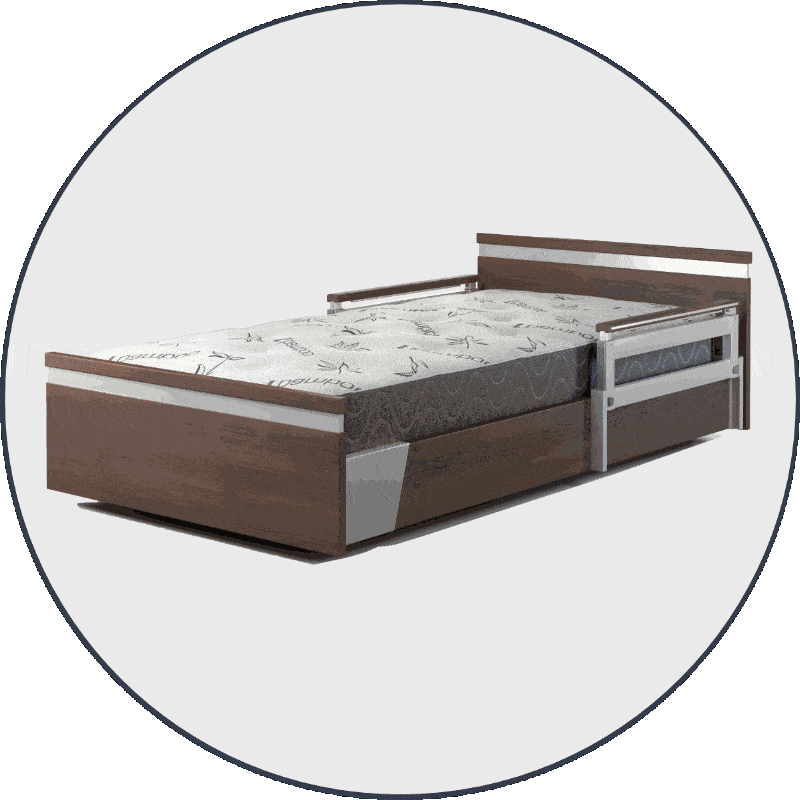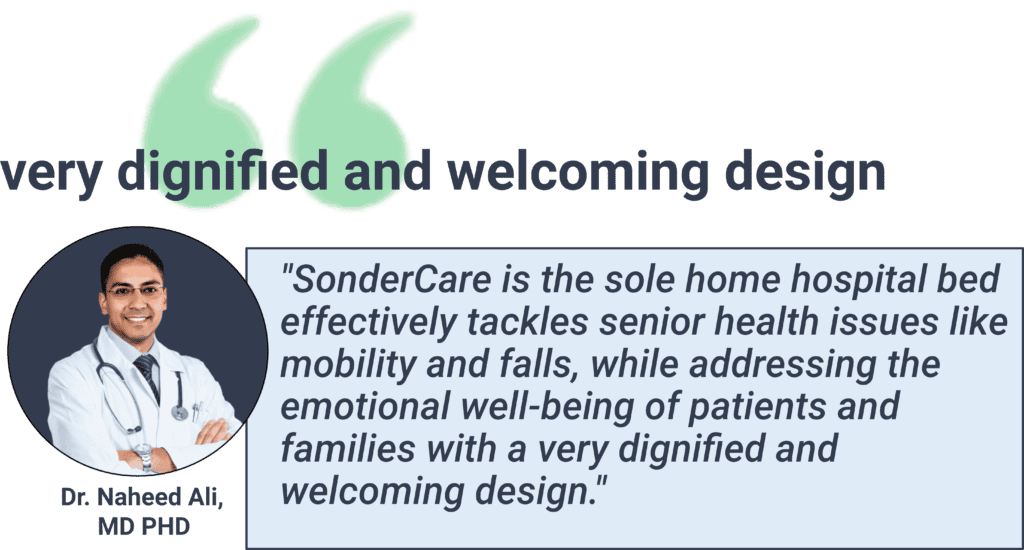Doctors frequently recommend adjustable beds for home healthcare patients because they improve mobility, reduce pressure ulcers, and enhance comfort. These beds help caregivers reposition patients safely and allow for better support in conditions like chronic pain, respiratory issues, or post-surgery recovery.
Research on discharge planning and home healthcare demonstrates that physicians and discharge planners consistently recommend adjustable beds for patients with specific medical conditions, particularly those involving mobility limitations, respiratory issues, or post-surgical recovery needs [1,2]. These recommendations aren’t just about comfort—they’re grounded in clinical evidence showing improved patient outcomes, reduced hospital readmissions, and enhanced quality of life for both patients and caregivers.
In this comprehensive guide, we’ll explore what medical professionals actually say about adjustable beds, the specific conditions that benefit most, and how to have an informed conversation with your healthcare provider about whether a hospital bed is right for your home care situation.
The Medical Perspective: What Doctors Say
Why Physicians Recommend Adjustable Beds
Healthcare providers don’t make equipment recommendations lightly. When physicians prescribe adjustable beds for home use, they’re addressing specific medical needs that standard flat beds simply cannot meet. The primary reasons doctors recommend these beds include therapeutic positioning capabilities, fall prevention, pressure injury prevention, and support for both patient independence and caregiver safety.
Modern hospital-certified adjustable beds offer precise positioning options that can significantly impact patient outcomes. Physicians value features like Trendelenburg positioning for circulation support, Cardiac Chair position for respiratory relief, and Zero-Gravity positioning for pressure redistribution. These aren’t luxury features—they’re therapeutic interventions that can prevent complications and support healing.
Common Medical Conditions That Benefit
Doctors most frequently recommend adjustable beds for patients with:
Respiratory Conditions: Chronic Obstructive Pulmonary Disease (COPD), asthma, and congestive heart failure patients benefit enormously from head elevation. The Cardiac Chair position reduces pulmonary congestion and makes breathing easier, particularly during sleep when symptoms often worsen.
Post-Surgical Recovery: Following orthopedic procedures (hip or knee replacement), cardiac surgery, or abdominal operations, precise positioning supports healing, reduces swelling, and manages post-operative pain. Elevation helps control edema while therapeutic angles prevent complications.
Mobility and Fall Risk: For patients with balance disorders, stroke recovery needs, or general frailty, the ultra-low height capability of medical-grade adjustable beds dramatically reduces fall-related injury risk. Studies show that reducing bed height to near-floor levels can decrease fall injury severity by up to 90%.
Chronic Pain Conditions: Arthritis, fibromyalgia, and chronic back pain sufferers find relief through customizable positioning that reduces pressure points and supports proper spinal alignment throughout the night.
Clinical Evidence Supporting Use
The medical literature consistently supports adjustable bed use for home healthcare patients. Research demonstrates that proper therapeutic positioning can reduce pressure ulcer incidence by up to 60% compared to flat beds [3,4]. Studies on respiratory patients show that head elevation improves oxygen saturation and reduces nighttime respiratory distress.
For post-surgical patients, adjustable beds have been linked to reduced recovery times, better pain management, and lower rates of post-operative complications. The ability to easily transition from lying to seated positions supports early mobilization—a critical factor in preventing complications like pneumonia and blood clots.
Hospital-certified beds, like those meeting FDA and ISO medical device standards, undergo rigorous testing to ensure they deliver consistent, safe therapeutic benefits. This certification level distinguishes medical-grade equipment from consumer adjustable mattresses that lack the precision, durability, and safety features physicians trust.
Key Medical Benefits Doctors Emphasize
Fall Prevention and Safety
Fall prevention ranks as the number one concern for physicians treating elderly or mobility-impaired patients at home. Traditional hospital beds and standard home beds pose significant fall risks, particularly during nighttime transfers. Medical-grade adjustable beds address this through ultra-low height technology that can lower the sleeping surface to within inches of the floor.
Statistics are compelling: falls from standard bed height (20-25 inches) result in hip fractures in approximately 20% of elderly patients who fall. Reducing bed height to 8-10 inches from the floor decreases not just the likelihood of injury, but the severity of injuries when falls do occur. Physicians particularly value this feature for patients with dementia, Parkinson’s disease, or those taking medications that affect balance.
Beyond height adjustment, integrated assist rails provide safe support for transfers without the entrapment risks associated with traditional bed rails. This combination of features gives physicians confidence that their patients can maintain independence while minimizing danger.
Pressure Redistribution and Wound Care
Pressure injuries remain a serious concern for home healthcare patients, particularly those with limited mobility. Physicians emphasize that medical-grade mattress systems paired with adjustable positioning create superior pressure redistribution compared to standard beds [3,4,5].
The alternating pressure technology found in advanced mattress systems continuously shifts contact points, promoting circulation and preventing the tissue damage that leads to pressure ulcers [5]. When combined with position adjustments that regularly change weight distribution, these systems provide comprehensive pressure injury prevention that physicians trust.
For patients already dealing with wounds, the ability to achieve precise positioning supports healing by relieving pressure from affected areas while maintaining overall comfort and proper alignment.
Respiratory and Circulation Support
Cardiologists and pulmonologists consistently recommend head elevation for patients with heart failure, COPD, and other cardiopulmonary conditions. The Cardiac Chair position—which elevates both the head and knees—reduces venous return to the heart, decreasing cardiac workload while improving lung expansion.
Research shows that even modest elevation (30 degrees) can significantly improve oxygen saturation in COPD patients and reduce nocturnal dyspnea in heart failure patients. The Trendelenburg position, which tilts the entire bed with feet elevated above the heart, supports venous return and can help manage orthostatic hypotension.
These positioning capabilities allow physicians to recommend environmental modifications that complement pharmaceutical treatments, potentially reducing medication requirements and improving overall disease management.
Pain Management and Comfort
Chronic pain specialists recognize that proper positioning is a cornerstone of non-pharmacological pain management. Zero-Gravity positioning—which elevates the legs above the heart while supporting the lumbar spine at an optimal angle—reduces spinal compression and distributes body weight evenly.
For arthritis patients, the ability to adjust positioning throughout the night prevents the stiffness and pain that comes from remaining in static positions. Post-surgical patients benefit from positions that reduce tension on incision sites while supporting proper healing alignment.
Physicians appreciate that improved pain control through positioning can reduce reliance on pain medications, minimizing side effects and dependency risks while improving sleep quality and daytime function.
Caregiver Ergonomics
Family physicians increasingly recognize that caregiver health directly impacts patient outcomes. Adjustable height functionality transforms caregiving tasks—turning, repositioning, wound care, bathing—from back-straining ordeals into manageable activities performed at ergonomic heights.
Studies show that caregivers using adjustable height beds report 70% fewer back and shoulder complaints compared to those using fixed-height beds. This matters because caregiver injury is a leading cause of premature nursing home placement. By protecting caregiver health, adjustable beds help sustain home-based care longer.
Hospital to Home Transition: What Discharge Planners Recommend
The Role of Discharge Planning
Discharge planners serve as the critical bridge between hospital care and home recovery. These healthcare professionals—typically registered nurses or social workers with specialized training—assess patient needs and coordinate the equipment, services, and support systems necessary for safe home transitions.
When evaluating equipment needs, discharge planners consider the patient’s specific diagnosis, mobility level, cognitive status, fall risk, wound care requirements, and home environment. They work closely with physicians, physical therapists, and occupational therapists to ensure equipment recommendations align with the treatment plan and support continued progress at home.
Discharge planners consistently emphasize that the right bed is foundational to successful home care. It affects medication effectiveness (proper positioning for drug absorption), treatment compliance (comfort encouraging bed rest when needed), and caregiver sustainability (reducing physical strain that leads to burnout).
Hospital Bed vs. Regular Adjustable Bed
A critical distinction that discharge planners stress: not all adjustable beds are created equal. Consumer adjustable mattresses marketed for comfort differ fundamentally from hospital-certified medical beds.
Medical-Grade Hospital Beds feature full electric control of head, foot, and height; therapeutic positioning preset programs; ultra-low height capability (often to 8-10 inches); medical-grade construction meeting weight and durability standards; compatibility with specialized mattress systems; and certifications from regulatory bodies like the FDA and ISO.
Consumer Adjustable Mattresses typically offer basic head and foot elevation; limited or no height adjustment; lighter construction unsuitable for intensive medical use; no regulatory medical certification; and limited compatibility with pressure-redistribution systems.
For patients with legitimate medical needs—not just comfort preferences—discharge planners strongly recommend hospital-certified beds that meet stringent safety and performance standards.
Certification Standards That Matter
Discharge planners and physicians look for specific certifications when recommending home hospital beds [1,2]. FDA registration as a Class I or II medical device ensures the bed meets safety standards for electrical components, mechanical stability, and user protection. ISO certification (particularly ISO 60601 for medical electrical equipment) guarantees international safety compliance.
These certifications aren’t just bureaucratic checkboxes—they represent rigorous testing for entrapment risks, weight capacity, emergency backup systems, and long-term durability under intensive medical use. They also ensure the bed can safely integrate with other medical equipment like IV poles, oxygen concentrators, and patient lifts.
Beyond medical certification, discharge planners increasingly value beds that address the psychological aspects of home care. Equipment that looks like furniture rather than hospital gear improves patient dignity and treatment compliance—factors that directly impact outcomes. When patients feel their home hasn’t become a hospital room, they’re more engaged in their recovery and more willing to use the safety features their condition requires.
Practical considerations matter too. Discharge planners value rapid delivery capabilities, especially for patients being discharged in crisis situations. The ability to receive professional installation within 24-48 hours—complete with white-glove setup and thorough demonstration—can make the difference between safe home transition and emergency readmission.
Specific Conditions Where Doctors Prescribe Adjustable Beds
Post-Surgical Recovery
Orthopedic Procedures: Following hip or knee replacement surgery, physicians prescribe adjustable beds to support the strict positioning requirements critical for proper healing. Hip replacement patients, for instance, must avoid certain angles that could dislocate the new joint. Adjustable beds with preset positions help maintain safe angles while providing the elevation needed to reduce post-operative swelling. Physical therapists can preset positions that support the rehabilitation exercises patients need to perform regularly.
Cardiac Surgery: After open-heart surgery or other cardiac procedures, the Cardiac Chair position reduces strain on the chest incision while supporting optimal breathing mechanics. The gradual position changes possible with electric adjustment prevent the sudden movements that could stress healing tissues. Leg elevation helps manage the edema common after cardiac procedures.
Abdominal Surgery: Post-operative abdominal surgery patients benefit from positions that reduce tension on incision sites while preventing the respiratory complications that can arise from prolonged flat positioning. The ability to easily transition from lying to semi-reclined positions supports the early mobilization that surgeons emphasize for preventing blood clots and pneumonia.
Chronic Conditions
COPD and Respiratory Diseases: Pulmonologists routinely prescribe adjustable beds for COPD patients. The elevated head position keeps airways more open, reduces nocturnal oxygen desaturation, and makes breathing less labored during sleep. Patients report better rest and fewer middle-of-the-night breathing crises when sleeping in properly elevated positions.
Congestive Heart Failure: Cardiologists recommend adjustable beds to manage the fluid retention and pulmonary congestion characteristic of heart failure. Elevation reduces the fluid pooling in lungs that causes the classic symptom of waking up gasping for air. The Trendelenburg tilt can also help with orthostatic hypotension that affects many heart patients.
Chronic Pain Conditions: Rheumatologists and pain specialists prescribe adjustable positioning for patients with fibromyalgia, chronic back pain, and arthritis. Zero-Gravity positioning relieves spinal compression, while the ability to change positions easily prevents the stiffness that comes from static positioning.
Neurological Conditions: Neurologists recommend adjustable beds for patients with MS, ALS, and Parkinson’s disease. These conditions often involve both mobility challenges (benefiting from ultra-low height) and positioning needs (benefiting from therapeutic angles). As these conditions progress, the bed’s adaptability supports changing needs without requiring new equipment.
Mobility and Fall Risk
Stroke Recovery: Physiatrists and neurologists prescribe adjustable beds as part of stroke rehabilitation. The adjustable height supports safe transfers as patients rebuild strength and coordination. Positioning options support the stretching and positioning exercises that prevent contractures and support neuroplasticity.
Balance Disorders: For patients with vertigo, vestibular disorders, or medication-induced balance issues, ultra-low height provides critical fall protection. Physicians emphasize that reducing injury risk allows patients to maintain more independence rather than restricting all activity out of fear.
General Frailty in Elderly: Geriatricians recommend adjustable beds for frail elderly patients even before specific diagnoses emerge. The combination of fall protection, positioning support for multiple body systems, and ease of use supports the comprehensive geriatric care approach of maintaining function and preventing decline.
Palliative and Hospice Care
Comfort Positioning: Palliative care physicians and hospice medical directors consistently recommend adjustable beds for end-of-life care. The ability to make gentle, precise positioning adjustments provides comfort when patients can no longer reposition themselves. This becomes especially important as pain and breathlessness increase.
Gentle Repositioning Needs: As patients become frailer, caregivers must reposition them frequently to prevent pressure injuries and maintain comfort. The electric height adjustment allows this repositioning without the lifting that could cause caregiver injury or patient discomfort.
Dignity in End-of-Life Care: Hospice teams emphasize that maintaining dignity is paramount. Adjustable beds that look like quality home furniture rather than hospital equipment support the goal of making the home environment as normal and peaceful as possible during the final stages of life.
What to Ask Your Doctor
Having the Conversation with Your Healthcare Provider
If you’re considering an adjustable bed for yourself or a loved one, bring these questions to your next medical appointment:
“Do you recommend a hospital bed for my condition?”
Be specific about your symptoms, challenges, and goals. Mention if you’re experiencing falls, difficulty breathing at night, pain that limits sleep, mobility challenges, or if you’re a caregiver struggling with the physical demands of care.
“What specific features should I look for?”
Ask which therapeutic positions would benefit your particular condition. Does your doctor recommend Trendelenburg tilt for circulation? Cardiac Chair for breathing? Zero-Gravity for back pain? Understanding which features address your specific needs helps evaluate options.
“How low should the bed go for fall prevention?”
If fall risk is a concern, ask your doctor what height they recommend. Most physicians suggest beds that can lower to 10 inches or less from the floor. Some medical-grade beds achieve heights as low as 8 inches.
“What certifications are important?”
Ask if your doctor recommends FDA-registered, hospital-certified beds versus consumer adjustable mattresses. Understanding the medical reasons for this distinction helps justify the investment.
“Do I need specialized mattress systems?”
Inquire whether your condition requires pressure redistribution, alternating pressure, or low air loss mattress technology. These specialized systems often work only with medical-grade bed frames.
“What positioning features will benefit my condition?”
Different conditions benefit from different positions. Ask your doctor to be specific about which positions support your treatment plan and how often you should use them.
Documenting Medical Necessity:
If insurance coverage is a possibility (though most Medicare doesn’t cover home hospital beds), ask your doctor to document the medical necessity in your chart. Even if insurance won’t cover it, this documentation helps justify the investment and may have tax implications as medical expense deductions.
Getting Prescriptions if Needed:
Some medical equipment providers, occupational therapy services, or institutional settings may require a physician’s prescription. Ask if your doctor can provide written orders for a hospital bed with specific feature requirements.
Beyond Medical Needs: The Quality of Life Factor
Independence and Dignity
While medical benefits drive physician recommendations, the psychological and emotional benefits of proper equipment can’t be overstated. Adjustable beds support independence in ways that profoundly affect quality of life.
When patients can control their own positioning with a simple remote, they maintain autonomy over their comfort. This self-determination matters enormously to psychological well-being, particularly for those already experiencing loss of independence in other life areas. The ability to adjust their bed without calling for help preserves dignity and reduces the feelings of being a burden that many home care patients struggle with.
Physical therapists note that patients using adjustable beds participate more actively in their own care, performing recommended position changes because they can do so independently. This engagement correlates with better outcomes and sustained motivation during long recovery periods.
Residential Aesthetics and Psychological Benefits
The stigma associated with “hospital equipment” in the home presents a real barrier to treatment compliance. Patients who resist using medically necessary equipment because it makes their home feel institutional miss out on critical health benefits.
Modern hospital-certified beds that incorporate furniture-grade design elements address this psychological barrier. When beds blend seamlessly with home décor—featuring wood finishes, integrated lighting, and concealed medical components—patients accept and use them more readily.
Research in environmental psychology shows that home environment directly affects mood, stress levels, and healing. Maintaining the feeling that “this is my home, not a hospital room” supports mental health during challenging medical circumstances. Family members report that furniture-quality medical beds help normalize their living space, reducing the daily visual reminders of illness that can contribute to caregiver depression and patient demoralization.
Family Caregiver Wellbeing
The American Medical Association recognizes that family caregiver health directly impacts patient outcomes. When caregivers sustain injuries, experience burnout, or develop their own health problems from caregiving strain, patients often face premature institutionalization.
Adjustable beds serve as intervention points for caregiver sustainability. The ergonomic benefits—reducing bending, heavy lifting, and awkward positions during care tasks—prevent the back injuries that plague family caregivers. Studies show that caregiver back pain and injury are among the top reasons families can no longer maintain home-based care.
Beyond physical benefits, the peace of mind from knowing fall risks are minimized and that their loved one can reposition for comfort independently reduces caregiver anxiety. This psychological relief allows caregivers to sleep better themselves, knowing their loved one has safety features and comfort options available through the night.
Quality adjustable beds also shift the relationship dynamic. Rather than spending time on physical care tasks, families can spend more time simply being together—reading, talking, sharing meals. This transition from burden-focused caregiving to quality time preservation matters enormously to both patient and caregiver emotional health.
Making an Informed Decision
Hospital-Certified vs. Consumer Models
When evaluating adjustable bed options, understanding the fundamental differences between hospital-certified medical beds and consumer adjustable mattresses helps ensure you invest in equipment that meets your medical needs.
Hospital-certified beds must meet stringent FDA medical device standards for safety, durability, and performance. They undergo testing for weight capacity (often 500+ pounds), electrical safety, entrapment prevention, and emergency features like backup power and emergency lowering mechanisms. These beds are engineered for intensive daily use over many years, with commercial-grade motors and mechanisms.
Consumer adjustable mattresses, while marketed with health-related language, don’t undergo the same regulatory scrutiny. They typically offer basic comfort positioning but lack the precision therapeutic angles, ultra-low height capability, and safety certifications that physicians value. They’re also not designed to accommodate the specialized mattress systems often required for medical conditions.
If a physician has recommended a hospital bed for medical reasons—not just comfort—the distinction matters. Consumer models may not deliver the therapeutic benefits your condition requires.
Key Features Doctors Value
From a medical perspective, essential features include:
Ultra-Low Height Capability: Beds that lower to 10 inches or less from the floor provide the fall protection physicians prioritize for at-risk patients.
Full Electric Operation: All adjustment functions (head, foot, height) should operate electrically. This allows patients to make position changes independently and supports caregiver ergonomics.
Therapeutic Positioning: Presets or programmable positions for Zero-Gravity, Cardiac Chair, and Trendelenburg provide the specific therapeutic benefits physicians recommend.
Medical-Grade Construction: Robust build quality ensures safety, reliability, and longevity under medical use conditions.
Quality Mattress Compatibility: The bed should accommodate specialized pressure redistribution mattresses if your condition requires them.
Safety Features: Integrated assist rails, emergency lowering capability, locking mechanisms, and entrapment-prevention design protect users.
Investment in Health and Safety
Hospital-certified adjustable beds represent significant investments, typically ranging from $3,000 to $10,000 depending on size and features. When weighing this cost, consider:
Long-term value: These beds are engineered for years of daily intensive use. Dividing the cost over the expected lifespan often reveals lower annual costs than alternatives like rental or frequent replacement of inadequate equipment.
Total cost of care: Preventing a single fall-related emergency room visit (average cost $3,000-$30,000 depending on injury severity) can justify the bed investment. Avoiding pressure injuries, which cost $20,000-$150,000 to treat, represents enormous potential savings.
Quality of life returns: The value of better sleep, reduced pain, maintained independence, and caregiver sustainability can’t be fully captured in dollars but profoundly impacts overall wellbeing.
Peace of mind: For many families, knowing their loved one has optimal safety features and therapeutic support provides psychological relief that enhances everyone’s quality of life.
The evidence is clear: doctors do recommend adjustable beds for home healthcare patients, and for good medical reasons. When physicians prescribe hospital-certified adjustable beds, they’re not suggesting luxury purchases—they’re recommending medical interventions backed by clinical evidence.
From fall prevention and pressure injury reduction to respiratory support and pain management, the therapeutic benefits of proper adjustable beds address real medical needs that standard beds cannot meet. The positioning capabilities, safety features, and medical-grade construction provide tools that support healing, prevent complications, and improve outcomes across numerous conditions.
Beyond the purely medical benefits, the right adjustable bed supports the broader goals of home healthcare: maintaining independence, preserving dignity, sustaining family caregiving, and making home a healing rather than institutional environment. When beds combine hospital-level functionality with residential aesthetics, they address both the clinical and psychological aspects of successful home care.
If you’re considering an adjustable bed for yourself or a loved one, consult with your healthcare team. Come prepared with specific questions about your condition’s needs and the features that would most benefit your situation. The investment in proper equipment—certified to medical standards, offering the therapeutic positioning your condition requires, and engineered for safety and reliability—represents an investment in health, independence, and peace of mind.
Creating a safe, comfortable home environment with the right medical equipment doesn’t just prevent complications—it preserves what matters most: the ability to live with dignity, comfort, and connection to family in the place you call home.
Key Takeaways: Doctors Recommending Adjustable Beds For Home Care
✓ Doctors actively recommend adjustable beds for patients with respiratory conditions, post-surgical recovery needs, chronic pain, mobility limitations, and fall risk
✓ Key medical benefits include fall prevention through ultra-low height, pressure injury prevention, respiratory support, pain management, and caregiver ergonomics
✓ Hospital certification matters – FDA and ISO certified beds meet medical device standards that consumer adjustable mattresses don’t
✓ Ultra-low height capability (8-10 inches from floor) is critical for fall prevention in at-risk patients
✓ Therapeutic positioning (Zero-Gravity, Cardiac Chair, Trendelenburg) provides evidence-based benefits for specific conditions
✓ Proper equipment supports independence and dignity – furniture-grade aesthetics reduce stigma and improve treatment compliance
✓ Caregiver health directly impacts patient outcomes – ergonomic features prevent caregiver injury and burnout
✓ Investment represents long-term value – preventing one serious fall or pressure injury can justify the cost while improving quality of life
Talk to a Hospital Bed Expert
If your doctor has recommended a hospital bed or you’re researching options for a loved one’s home care needs, speaking with knowledgeable experts can help you make the right choice.
SonderCare’s hospital bed specialists bring over 10 years of experience helping families select equipment that meets medical needs while preserving home comfort and dignity. Our non-commissioned experts take time to understand your specific situation, answer questions about therapeutic features and certifications, and guide you toward solutions that support both patient and caregiver wellbeing.
With white-glove delivery available in as little as 24-48 hours across the U.S. and Canada, we support families facing both planned transitions and urgent discharge situations. Our trained technicians handle complete in-room setup, provide thorough demonstrations, and ensure you’re comfortable with all features before they leave.
Ready to learn more? Call 1-833-649-7772 to speak with a hospital bed expert, or explore our complete line of hospital-certified adjustable beds designed to blend medical functionality with residential elegance.
Because proper equipment isn’t about accepting limitation—it’s about supporting independence, comfort, and the precious time families have together at home.
References
- Clemson L, Lannin NA, Wales K, Salkeld G, Rubenstein L, Gitlin L, Barris S, Mackenzie L, Cameron ID. (2016). Occupational Therapy Predischarge Home Visits in Acute Hospital Care: A Randomized Trial. Journal of the American Geriatrics Society, 64(10):2019-2026. doi: 10.1111/jgs.14287. https://pubmed.ncbi.nlm.nih.gov/27603152/
- Lannin NA, Clemson L, Drummond A, Stanley M, Churilov L, Laver K, O’Keefe S, Cameron I, Crotty M, Usherwood T, Andrew NE, Jolliffe L, Cadilhac DA. (2021). Effect of occupational therapy home visit discharge planning on participation after stroke: protocol for the HOME Rehab trial. BMJ Open, 11(7):e044573. doi: 10.1136/bmjopen-2020-044573. https://pubmed.ncbi.nlm.nih.gov/34226214/
- Alderden JG, Shibily F, Cowan L. (2020). Best Practice in Pressure Injury Prevention Among Critical Care Patients. Critical Care Nursing Clinics of North America, 32(4):489-500. doi: 10.1016/j.cnc.2020.08.001. https://pubmed.ncbi.nlm.nih.gov/33129409/
- Gillespie BM, Walker RM, Latimer SL, Thalib L, Whitty JA, McInnes E, Chaboyer WP. (2020). Repositioning for pressure injury prevention in adults. Cochrane Database of Systematic Reviews, 6(6):CD009958. doi: 10.1002/14651858.CD009958.pub3. https://pubmed.ncbi.nlm.nih.gov/32484259/
- Shi C, Dumville JC, Cullum N, Rhodes S, Jammali-Blasi A, McInnes E. (2021). Alternating pressure (active) air surfaces for preventing pressure ulcers. Cochrane Database of Systematic Reviews, 5(5):CD013620. doi: 10.1002/14651858.CD013620.pub2. https://pubmed.ncbi.nlm.nih.gov/33969911/
- Lu W, Silvera-Tawil D, Yoon HJ, Higgins L, Zhang Q, Karunanithi M, Bomke J, Byrnes J, Hewitt J, Smallbon V, Freyne J, Prabhu D, Varnfield M. (2025). Impact of the Smarter Safer Homes Solution on Quality of Life and Health Outcomes in Older People Living in Their Own Homes: Randomized Controlled Trial. Journal of Medical Internet Research, 27:e59921. doi: 10.2196/59921. https://pubmed.ncbi.nlm.nih.gov/39608020/
- Schwei RJ, Amesoudji AW, DeYoung K, Madlof J, Zambrano-Morales E, Mahoney J, Jacobs EA. (2020). Older adults’ perspectives regarding peer-to-peer support programs and maintaining independence. Home Health Care Services Quarterly, 39(3):139-155. doi: 10.1080/01621424.2020.1778594. https://pubmed.ncbi.nlm.nih.gov/32525461/
- Sullivan SS, Mann C, Mullen S, Chang YP. (2021). Homecare nurses guide goals for care and care transitions in serious illness: A grounded theory of relationship-based care. Journal of Advanced Nursing, 77(4):1960-1972. doi: 10.1111/jan.14739. https://pubmed.ncbi.nlm.nih.gov/33502029/
- Beaudoin M, Lettre J, Routhier F, Archambault PS, Lemay M, Gélinas I. (2019). Long-term use of the JACO robotic arm: a case series. Disability and Rehabilitation: Assistive Technology, 14(3):267-275. doi: 10.1080/17483107.2018.1428692. https://pubmed.ncbi.nlm.nih.gov/29385842/
- Bose S, Groat D, Dinglas VD, Akhlaghi N, Banner-Goodspeed V, Beesley SJ, Greene T, Hopkins RO, Mir-Kasimov M, Sevin CM, Turnbull AE, Jackson JC, Needham DM, Brown SM. (2023). Association Between Unmet Nonmedication Needs After Hospital Discharge and Readmission or Death Among Acute Respiratory Failure Survivors: A Multicenter Prospective Cohort Study. Critical Care Medicine, 51(2):231-240. doi: 10.1097/CCM.0000000000005709. https://pubmed.ncbi.nlm.nih.gov/36661449/
















